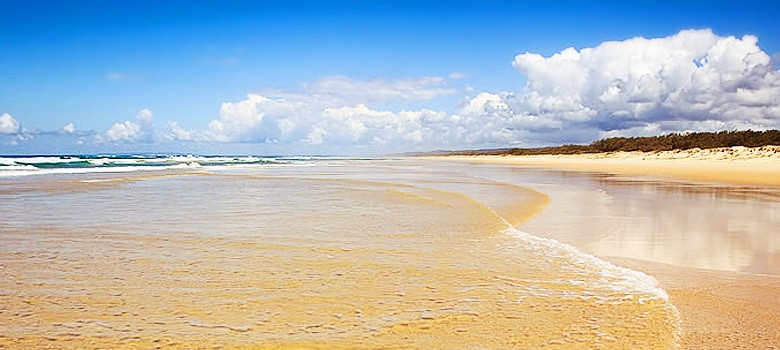
A view of the Earth from space on September 21, 2005, with the full Antarctic region visible. Credit: NASA/Goddard Space Flight Center
AWI study provides the basis for reliable projections of the impacts of climate change in the Antarctic.
Despite global warming and the sea-ice loss in the Arctic, the Antarctic sea-ice extent has remained largely unchanged since 1979. However, existing climate model-based simulations indicate significant sea-ice loss, contrary to actual observations. As experts from the Alfred Wegener Institute have now shown, the ocean may weaken warming around Antarctica and delay sea-ice retreat. Given that many models are not capable of accurately reflecting this factor and the role of ocean eddies, the study, which was just published in the journal Nature Communications, provides the basis for improved simulations and forecasts of the future development of the Antarctic.
Global warming is progressing rapidly, producing effects that can be felt around the world. The impacts of climate change are especially dramatic in the Arctic: since the beginning of satellite observation in 1979, the sea ice has declined massively in the face of rising global temperatures. According to the latest simulations, the Arctic could be consistently ice-free in summer before 2050, and in some years even before 2030.
Yet on the other side of the planet in Antarctica, the sea ice seems to have evaded the global warming trend. Since 2010, there have been more interannual fluctuations than in the previous period. However, apart from a significant negative excursion in the years 2016 to 2019, the long-term mean sea-ice cover around the Antarctic continent has remained stable since 1979. As such, the observable reality does not match the majority of scientific simulations, which show a significant sea-ice loss over the same timeframe.
“This so-called Antarctic sea-ice paradox has preoccupied the scientific community for some time now,” says first author Thomas Rackow from the Alfred Wegener Institute, Helmholtz Centre for Polar and Marine Research (AWI). “The current models cannot yet correctly describe the behavior of the Antarctic sea ice; some key element seems to be missing. This also explains why the Intergovernmental Panel on Climate Change, IPCC, concludes that the confidence level for model-based projections of future Antarctic sea ice is low.” In contrast, the models are already so reliable in the Arctic that the IPCC ascribes a high confidence level to their projections. “With our study, we now provide a basis that could make future projections for Antarctica much more reliable.”
In the course of the study, the team applied the AWI Climate Model (AWI-CM). Unlike other climate models, the AWI-CM allows certain key regions like the Southern Ocean to be simulated in far more detail – or in other words, in “high resolution.” As a result, mixing processes in the ocean, caused by smaller ocean eddies with diameters of 10 to 20 kilometers, can also be directly included.
“We used a broad range of configurations for our simulations. In the process, it became clear that only those simulations with a high-resolution description of the Southern Ocean encircling the Antarctic produced delayed sea-ice loss similar to what we are seeing in reality,” says Rackow. “When we then extended the model into the future, even under a highly unfavorable greenhouse-gas scenario the Antarctic sea-ice cover remains largely stable until mid-century. After that point the sea ice retreats rather rapidly, just as the Arctic sea ice has been doing for decades.”
As such, the AWI study offers a potential explanation for why the behavior of the Antarctic sea ice does not follow the global warming trend. “There could be a number of reasons for the paradoxical stability of the sea-ice cover. The theory that additional melt water from the Antarctic stabilizes the water column and thus also the ice by shielding the cool surface waters from the warmer deep waters is being discussed. According to another theory, the prime suspects are the westerlies blowing around the Antarctic, which have been strengthening under climate change. These winds could essentially spread out the ice like a thin pizza dough, so that it covers a greater area. In this scenario, the ice volume could already be declining, while the ice-covered areas would give the illusion of stability,” Rackow explains.
AWI’s research efforts now bring ocean eddies into the focus. These could play a decisive part in dampening and thus delaying the effects of climate change in the Southern Ocean, allowing the ocean to transport additional heat taken up from the atmosphere north, toward the Equator. This northward heat transport is closely linked to the underlying overturning circulation in the upper about 1,000 meters of the ocean, which in the Southern Ocean is driven by the wind on the one hand but is also influenced by eddies. While the northward component of the circulation is growing due to stronger westerlies, the simplified eddies in low-resolution climate models often seem to overcompensate for this factor by a southward component toward Antarctica; the explicitly simulated eddies in the high-resolution model display a more neutral behavior. Taken together, a more pronounced northerly change in heat transport can be seen in the high-resolution model. As a result, the ocean surrounding the Antarctic warms more slowly and the ice cover remains stable for longer.
“Our study supports the hypothesis that climate models and projections of the Antarctic sea ice will be far more reliable as soon as they are capable of realistically simulating a high-resolution ocean, complete with eddies,” says Rackow. “Thanks to the ever-increasing performance of parallel supercomputers and new, more efficient models, next-generation climate models should make this a routine task.”
Reference: “Delayed Antarctic sea-ice decline in high-resolution climate change simulations” by Thomas Rackow, Sergey Danilov, Helge F. Goessling, Hartmut H. Hellmer, Dmitry V. Sein, Tido Semmler, Dmitry Sidorenko and Thomas Jung, 2 February 2022, Nature Communications.
DOI: 10.1038/s41467-022-28259-y
Note: This article have been indexed to our site. We do not claim legitimacy, ownership or copyright of any of the content above. To see the article at original source Click Here













